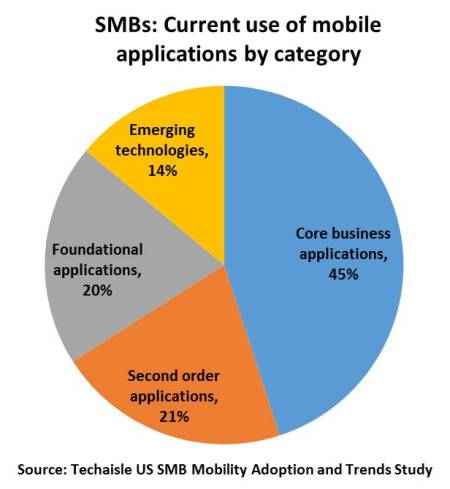Techaisle Blog
Mobile App Adoption exploding within SMBs and Midmarket Businesses
Data drawn from the Techaisle SMB mobility survey shows that SMBs will go from a current average of 7 types of mobility applications in use to 14 in about a year. This 100%-ish growth pattern is demonstrated across most employee size segments.
When we overlay business size with Techaisle’s attitudinally-defined segments of “Pre-IT,” “Basic IT,” “Advanced IT” and “Enterprise IT,” some differences in app adoption emerge. Businesses in the “Pre-IT” segment (found only in the small business group) are currently using only 3 types of mobile apps, versus 7 type of mobile apps in use in each of the “Basic IT: Small Business” and “Advanced IT: Small Business” segments.
This same trend is visible across the three attitudinally-defined midmarket segments. “Basic IT” firms in the midmarket segment are using only 4 types of mobile apps, and planning to add 5 more; both figures are below the adoption rates seen in Basic IT in the small business community.
The more sophisticated segments, though, are adopting mobile applications much more rapidly. The Advanced IT: Midmarket group uses an average of 8 different types of mobile applications today, and is planning to add 6 more in in the next one year, figures that tie very closely to Advanced IT users in the small business community. And the Enterprise IT segment found only within midmarket firms is even more aggressive in mobile app deployment; these firms already use mobile applications in an average of 11 types of apps, and are planning to deploy 9 more.
Mobile applications: scope for growth in core apps and in other categories
The Techaisle SMB mobility adoption survey tracks 20 types of mobile applications. Although there is always overlap between different feature sets and application types, its possible – and useful – to group these into four categories:
Core business applications that address tasks common to most businesses. Core business applications tracked through this research include time and billing management, logistics management, accounting/finance, field service applications, vertical applications, CRM, payroll, supply chain inventory management, and HR management.
Second-order applications are those that build off of core business applications, delivering increased functionality to the business by combining features and outputs from multiple core apps. Second-order applications tracked through this research include business intelligence, ERP/order management, marketing automation and payment processing.
Foundational applications are those that provide functionality to users, and potentially, to other apps as well – for example, web-video conferencing can be integrated into other functional apps, or users may rely on productivity suites or collaborative applications to connect outputs from various core applications into a single process workflow. Foundational applications business productivity suites and mobile collaboration solutions.
Emerging technologies are those that deliver net-new functionality that is unique to mobility or results from mobile connections. This research tracks three emerging technologies: location-enabled applications, mobile marketing and advertising and social media marketing.
Techaisle tracks adoption of 20 applications by small businesses and midmarket firms. Despite individual differences seen in these 20 application areas, small and midmarket firms allocate almost exactly the same relative degree of attention to the four application categories of core, second-order, foundational and emerging technologies. In fact, an analysis of current distribution of aggregate use across these four areas shows that, except for the slight difference in emphasis on emerging technologies noted above, the proportion of apps in each category (after rounding) is identical across small and midmarket businesses.

Looking ahead, the data shows that small businesses plan to be much more aggressive than their midmarket peers in new mobile application adoption. If and when these purchase intentions materialize, mobile apps will be very firmly entrenched within the small business group. Driven by anticipated purchases, small business is expected to have at least 10% greater usage levels in 11 of the 20 application categories tracked through Techaisle research, and has lower overall installation intentions than midmarket businesses in only two categories, mobile time and billing management and mobile BI.
Although much of the public debate around mobility involves hardware brands and feature sets and overall penetration rates, the real business benefit of mobility is delivered via applications that address specific task requirements within the business, and mobility solutions that overlay the management and security structures needed to integrate these apps with corporate IT systems.
When you subscribe to the blog, we will send you an e-mail when there are new updates on the site so you wouldn't miss them.











